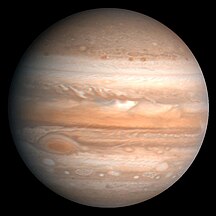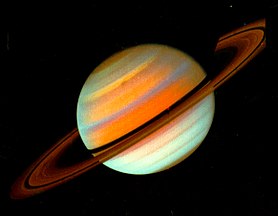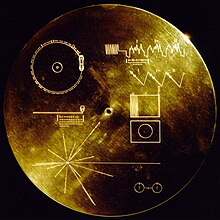Voyager 1
| Voyager 1 | |||||||||||||||||||||||||||||||
|---|---|---|---|---|---|---|---|---|---|---|---|---|---|---|---|---|---|---|---|---|---|---|---|---|---|---|---|---|---|---|---|
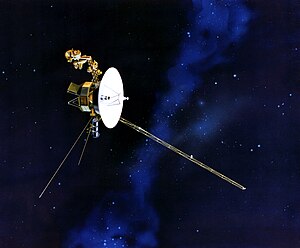 Artist's impression of a Voyager probe in space |
|||||||||||||||||||||||||||||||
| NSSDC ID | 1977-084A | ||||||||||||||||||||||||||||||
| Mission goal | Investigation of the planets Jupiter and Saturn and their moons | ||||||||||||||||||||||||||||||
| Client |
|
||||||||||||||||||||||||||||||
| Launcher | Titan IIIE Centaur | ||||||||||||||||||||||||||||||
| construction | |||||||||||||||||||||||||||||||
| Takeoff mass | 825.50 kg | ||||||||||||||||||||||||||||||
| Instruments | |||||||||||||||||||||||||||||||
|
CRS, ISS, IRIS, LECP, PPS, PLS, PWS, PRA, RSS, MAG, UVS |
|||||||||||||||||||||||||||||||
| Course of the mission | |||||||||||||||||||||||||||||||
| Start date | 5th September 1977 | ||||||||||||||||||||||||||||||
| launch pad | Cape Canaveral AFS Launch Complex 41 | ||||||||||||||||||||||||||||||
| End date | Scientific activities: approx. 2025, contact: approx. 2036 | ||||||||||||||||||||||||||||||
|
|||||||||||||||||||||||||||||||
Voyager 1 ( English voyager 'traveler') is a space probe of the US space agency NASA to explore the outer planetary system and interstellar space as part of the Voyager program . It was launched on September 5, 1977 from Launch Complex 41 on Cape Canaveral with a Titan IIIE Centaur rocket. Its sister probe, Voyager 2 , of identical construction , had already started 16 days earlier on a different trajectory. Voyager 1 first flew to the planets Jupiter and Saturn and entered interstellar space around August 2012 as the first human-made object .
The mission of Voyager 1, like that of Voyager 2, is considered to be one of the greatest successes of NASA and space travel in general. The probe continues to send data to Earth on a regular basis . In addition, it is the most distant human-built object and will keep this status for the foreseeable future. Currently (August 24, 2020) Voyager 1 is approximately 150.16 astronomical units (AU) from the Sun (approximately 22.46 billion kilometers). Every year the distance increases by around 3.6 AU (approx. 540 million km), which corresponds to a (radial) speed of around 61,000 km / h. When viewed from Earth, Voyager 1 is in the constellation of the Serpent Bearer .
prehistory
The roots of the Voyager program go back to the mid-1960s. There have been calculations of trajectories for probes that should take advantage of the favorable positions of the outer planets in the late 1970s. It was decided to build Voyager 1 and 2 in the early 1970s. Since they were originally planned as an extension of the Mariner series, the probes were initially referred to as Mariner 11 and 12 . This designation was later dropped due to the large structural differences between the probes. By March 1975 the concept phase had been completed and construction of the two probes began.
Mission objectives
Original mission objectives
The Voyager probes had no particular research focus. Since there was only little knowledge about the outer planets at this point in time, this knowledge should be expanded. Therefore, the original mission objectives were relatively broad:
- Investigation of the atmosphere of Jupiter and Saturn with regard to circulation , structure and composition
- Analysis of the geomorphology , geology and composition of the moons
- more precise determination of the mass, size and shape of the planets, all moons and rings
- Investigation of various magnetic fields with regard to their field structure
- Analysis of the composition and distribution of charged particles and plasma
- Focus on the moons Io and Titan
Current interstellar mission
While Voyager 2 flew further from Saturn in the direction of Uranus and Neptune , Voyager 1 has been on its way to the outer areas of the solar system and into interstellar space since the flyby of Saturn . On January 1, 1990, the Voyager Interstellar Mission (VIM) began the final phase of the exploratory mission.
Voyager 1 is currently investigating the following phenomena:
- the strength and orientation of the sun's magnetic field
- the composition, direction and energy spectra of solar wind and cosmic rays
- the strength of radio waves, presumably from the heliopause come
- the distribution of hydrogen in the area of the outer heliopause.
The program came under pressure several times for budgetary reasons, as the operation of the probe costs several million US dollars per year (personnel, DSN time, etc.). International protests and the special position of Voyager 1 and Voyager 2 always prevented the complete discontinuation of the program, whereby some budget cuts had to be accepted.
The probe and its scientific instruments
Voyager 1 is a space probe several meters in size and weighing around 800 kg . It essentially consists of a central, ring-shaped aluminum cell (diameter approx. 1.80 m), which is decagonal in cross-section and houses a large part of the electronics, a parabolic antenna (diameter approx. 3.6 m) and a 2.5 m long one Cantilever that carries most of the scientific instruments. The energy comes from three radionuclide batteries . Voyager 1 and Voyager 2 are identical.
Course of the mission
begin
Voyager 1 was launched on September 5, 1977 - 16 days after its sister probe Voyager 2 - from Launch Complex 41 on Cape Canaveral with a Titan IIIE Centaur rocket. A 30-day test phase for the on-board systems and scientific instruments began 13 days after the start and was successful. Due to the slightly higher take-off speed (15.0 km / s versus 14.5 km / s), Voyager 1 overtook its sister probe on December 15 at a distance of 1.75 AU from the sun. The probe was in standby mode for most of the flight. Only every two months there was a 20-hour science phase in which the starry sky was examined and the particle measuring devices were switched on.
Exploring Jupiter
Due to its speed advantage, Voyager 1 arrived first in the Jupiter system. Scientific observations began on January 4, 1979, 60 days before the planet fly by.
The main phase of the investigation began on March 4, 1979, when the probe was only a day away from Jupiter. In addition to the planet itself and its rings, the moon Io was also examined, which the probe approached up to 18,460 km on March 5. On the same day Ganymede were examined at a distance of 112,030 km and Europe at a distance of 732,270 km. The next day, Voyager 1 was approaching the last to be examined moon Callisto up to 123,950 km on. The probe passed the four major moons of Jupiter in just 30 hours. A total of 17,477 images with the maximum data rate of 115.2 kbit / s were transmitted during the investigation of the Jupiter system.
Voyager 1 was accelerated to about 16 km / s by Jupiter. 5 kg of hydrazine had to be used for course corrections. Shortly after Voyager 1 sent the last images, Voyager 2 entered the system on April 25th and continued observing. Thus, Jupiter was observed over a period of almost seven months, which led to many new scientific discoveries.
While flying through the system, Voyager 1 discovered two new moons, Metis and Thebe , as well as the faint planetary ring around Jupiter, whose existence had already been suspected after the Pioneer 11 mission. On Io , Voyager 1 discovered nine active volcanoes. After the flyby of Jupiter, lightning could be seen on its night side from millions of kilometers away , which indicated extremely violent thunderstorms within Jupiter's atmosphere.
Jupiter's Big Red Spot in false colors
Eruption of a volcano on Io
Recording Kallistos " Valhalla Crater "
Low resolution image of the moon Amalthea
The moon Ganymede
Exploration of Saturn
On November 10, 1980, Voyager 1 arrived at the core of the Saturn system, nine months before its sister probe . The next day, the moon Titan was examined. The methane atmosphere was already known before the mission , and some scientists thought it possible that the greenhouse effect could possibly make life on the surface possible. But even at a greater distance one could see the homogeneous smog cloud of the moon, which made an examination of the surface impossible. Therefore, the IRIS and UVS instruments were aimed at the edge of the atmosphere in order to be able to analyze at least this precisely. Despite the surface of titanium, which was not investigatable at the time, some new knowledge could be gained about its atmosphere. In addition to the large proportion of nitrogen , traces of methane, ethene and other hydrocarbons were also discovered. The atmosphere itself was recognized as very extensive and dense, but clearly too cold for life. These findings made the moon the primary target of the Cassini-Huygens probe launched in 1997 .
After passing Saturn on November 12, 1980, one of the most demanding phases of the mission began. Since the other moons to be examined had an orbit very close to Saturn, all three moons ( Mimas , Dione and Rhea ) as well as the pronounced planetary ring had to be examined within only ten hours, which brought the scanning platform to its technical limits. The data rate had meanwhile dropped to 44.8 kbit / s due to the distance to earth that had been reached in the meantime, whereby the transmission started much earlier than with Jupiter, since Saturn with its ring system is significantly larger. In the end, about the same number of pictures were taken as with Jupiter.
Numerous new, small-sized moons have been found on the edges of the rings. Several other companions were also discovered at the moons' Lagrange points . This phenomenon was already known for planets (some planetoids also follow Saturn at ± 60 ° ), but it was a novelty for moons. Voyager 1 also showed that the planetary ring of Saturn is not homogeneous and consists of many individual rings. Since Voyager 1 did not describe a favorable trajectory for a more detailed examination of Saturn's rings and the PPS instrument had failed, the trajectory of the following Voyager 2 was reprogrammed in order to be able to analyze the rings from a better path.
When flying past Saturn's south pole, the probe swiveled into its final orbit at an angle of 35 ° to the ecliptic .
The moon Mimas with its characteristic Herschel impact crater
The moon Dione
Titan's atmosphere
Family portrait and pale blue dot
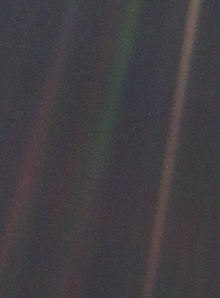
On February 14, 1990, the ISS instrument was activated one last time to create a unique photo mosaic that shows six planets of the solar system in color. Scientifically, it had no greater value, but it inspired many scientists and lay people: the so-called family portrait.
The image of the earth, called Pale Blue Dot , in particular attracted a lot of attention and was voted one of the ten best photos in space science in 2001. To this day it is the photo that shows the earth taken from the greatest distance (6.4 billion km).
Interstellar mission

While Voyager 2 flew further from Saturn in the direction of Uranus and Neptune, Voyager 1 had been on its way to the outer regions of the solar system and into interstellar space since the Saturn passage. The last phase of the mission began on January 1, 1990: the “Voyager Interstellar Mission” (VIM). In February 1998, Voyager 1 “overtook” the Pioneer 10 probe and has since become the most distant human-created object, as well as the fastest-escaping object in the solar system.
In the period between August 2002 and February 2003, the particle sensors measured continuously unusual values, which is why you surmised, that Voyager 1 to the preliminary goal of their journey was approaching: the large, outer region of the heliosphere , the Helio shell (heliosheath) . In this area, the particles of the solar wind mix with interstellar matter and move with reduced flow speed. The edge shock wave at the border to the Helio hull ( termination shock ) reached the probe on December 16, 2004 at a distance of 94 AU (about 14.1 billion km). This was recognized, among other things, by the massively slowing solar wind and the abruptly changing direction of the magnetic field, which also became 150% stronger. An increase in heavy ions was also recorded and previously unregistered radio emissions were recorded.
On March 31, 2006, an international group of radio amateurs from AMSAT succeeded in receiving signals from Voyager 1 with the parabolic antenna (diameter 20 meters) from the Bochum observatory . At that time, the probe was at a distance of 98 AU.
On December 23, 2009, NASA announced that the data from Voyager magnetometers indicated a strong magnetic field outside the solar system. This discovery provided the long-sought explanation for why the Local Interstellar Cloud does not dissolve: The cloud is strongly magnetized and is therefore held together by the field.
In the spring of 2010 further indications for the approach of the probe to the heliopause were found. These are based on the data of the LECP instrument, which registered a strong deceleration of the solar wind: The speed of the wind relative to the probe was almost zero during the measurement period (i.e. approx. 17 km / s relative to the sun), which reduces the influence of the Sun means.
With the help of the MAG instrument, Voyager was able to analyze the structure of the solar magnetic field at the edge of the solar system through direct measurements. Since 2007, the probe has been in a region where the field is no longer stable but is divided into several magnetic bubbles with a diameter of around 160 million kilometers. In June 2011 NASA announced that this is likely due to the rotation of the sun. This also moves and folds their magnetic field, which in the equatorial plane at the edge of the solar system leads to a large number of reconnections and thus to the “foam-like” structure of the field.
Beginning on August 25, 2012, there was a sharp drop in the anomalous cosmic radiation ( ACR ) measured by the probe (resulting in interaction with the solar wind ) and a significant increase in galactic cosmic radiation ( GCR ). This was an indication that Voyager 1 had reached the heliopause and thus left the heliosphere. Later analysis of the data showed, however, that although the intensity had decreased, the direction of the particles had not changed. Voyager 1 would therefore still have been in the heliosphere. Further measurements from April 9, 2013 showed oscillations caused by solar storms the year before. This made it possible to determine the plasma density, which was 40 times higher than in the outer layers of the heliosphere. Using comparative calculations and extrapolations, the research team at JPL determined that Voyager 1 had passed the heliopause in August 2012 and has been in interstellar space since then.
In order to better align an antenna towards Earth, on November 29, 2017, NASA was able to successfully reactivate some thrusters for short impulses that were last used in November 1980 near Saturn. With this measure, NASA hopes to extend the life of the probe by two to three years.
Solar system and interstellar space up to Alpha Centauri - proportions on a logarithmic scale
future
In about 40,000 years, Voyager 1 will pass the star Gliese 445 ( constellation Giraffe ), which is currently around 17 light-years away from the Sun, 1.6 light-years away. Gliese 445 will be only 3.45 light years away from the Sun at this point, as it is moving towards us at high speed.
Current status
power supply
The hydrazine fuel for attitude control will be sufficient until at least 2040. The energy supply is much more critical: due to the progressive radioactive core decay in the radionuclide batteries and the wear and tear of the thermoelectric elements, the available electrical power drops by around 1.4% per year. Therefore, many instruments and their heating elements have already been switched off. The last scientific instrument will have to be deactivated around 2023.
probe
- Distance from Earth: approx. 150.16 AU
- Speed relative to the sun: approx. 17 km / s or 3.6 AU / year
- Distance covered: 28,830,000,000 km = 179.95 AU (as of August 9, 2018)
- Remaining fuel: 17.38 kg (as of January 16, 2015)
- Radionuclide battery power: 254.6 W (approx. 46% power loss) (as of January 16, 2015)
- Real-time data rate: 160 bit / s (with 34 m antennas of the DSN )
- Maximum data rate (every 6 months): 1.4 kbit / s (with 70 m antennas of the DSN)
Instruments
Status: 2017
| instrument | status | Remarks |
|---|---|---|
| Cosmic Ray Sub-system (CRS) | active | |
| Imaging Science System (ISS) | deactivated | |
| Infrared Interferometer Spectrometer (IRIS) | deactivated | |
| Low-Energy Charged Particles (LECP) | active | |
| Photopolarimeter System (PPS) | malfunction | A filter is in an invalid position. |
| Plasma Spectrometer (PLS) | malfunction | |
| Plasma Wave System (PWS) | damaged | Reduced sensitivity in the upper 8 channels, broadband receiver defective. |
| Planetary Radio Astronomy (PRA) | deactivated | |
| Radio Science Sub-system (RSS) | deactivated | |
| Magnetometer (MAG) | active | |
| Ultraviolet Spectrometer (UVS) | deactivated |
Voyager Golden Record
Voyager 1 carries a data disk made of copper that is coated with gold to protect against corrosion , the so-called "Voyager Golden Record". Image and audio information about humanity is stored on it. On the front there is a kind of instruction manual and a map that shows the position of the sun in relation to 14 pulsars .
Popular culture reception
Voyager 1 and its sister probe, Voyager 2 , attracted a lot of attention, especially during their early mission phase, including among the general public. This is mainly due to the extraordinary mission profile (especially with regard to the distances covered) and the high quality color photos of various subjects for the time. The idea of sending a “message into space” using the Voyager Golden Record also attracted a lot of attention.
See also
literature
- Ben Evans: NASA's Voyager Missions . Springer-Verlag, London 2004, ISBN 1-85233-745-1 .
- Reiner Klingholz: Voyagers Grand Tour . Smithsonian Institute Press, 2003, ISBN 1-58834-124-0 .
- Paul Weissman, Alan Harris: The Great Voyager Adventure: A Guided Tour Through the Solar System . Julian Messner, 1990, ISBN 0-671-72538-6 .
- William E. Burrows: Mission to Deep Space: Voyager's Journey of Discovery . W. H. Freeman & Co. Ltd., 1993, ISBN 0-7167-6500-4 .
- Reiner Klingholz: Marathon in space: The unique journey of the spaceship Voyager 2 . Westerman, Braunschweig 1989, ISBN 3-07-509233-9 .
Web links
- Voyager project side of the NASA (English)
- Detailed technical description of the Voyager probes
- Nasa Images Voyager
- NSSDC Information Voyager 1 ( National Space Science Data Center )
- Information about the distance and direction of Voyager 1 from the sun . The table shows the year and day of the year as the date. NASA's website for data retrieval can be found here.
- Spektrum.de : Voyager-1 ignites old thrusters. 4th December 2017.
Individual evidence
- ↑ NASA Spacecraft Embarks on Historic Journey Into Interstellar Space.
- ↑ NASA query tool (English).
- ↑ NASA's Voyager project website (English).
- ↑ Voyage To Jupiter. (PDF; 106 MB) NASA, 1981, pp. 66, 68 and 73 , accessed on September 9, 2019 (English, PDF page numbers, not original page numbers of the scanned document).
- ↑ Experts' Favorite Space Photos.
- ↑ AMSAT-SE: VOYAGER 1 received by AMSAT-DL group. April 2, 2006, accessed October 27, 2018 .
- ↑ Voyager Makes to Interstellar Discovery. ( Memento of December 7, 2014 in the Internet Archive ).
- ↑ NASA Probe Sees Solar Wind Decline. At: JPL.NASA.gov. December 13, 2010, accessed January 3, 2011.
- ^ A b Tony Phillips: A Big Surprise from the Edge of the Solar System. NASA's Goddard Space Flight Center, accessed June 11, 2011 .
- ^ WR Webber, FB McDonald, AC Cummings, EC Stone, B. Heikkila, N. Lal: At Voyager 1 Starting on about August 25, 2012 at a Distance of 121.7 AU From the Sun, a Sudden Disappearance of Anomalous Cosmic Rays and an Unusually Large Sudden Increase of Galactic Cosmic Ray H and He Nuclei and Electron Occurred. On: arxiv.org. December 4, 2012, accessed July 25, 2014.
- ^ Voyager 1 Cosmic Ray (LA1 rate). ( Memento of July 14, 2015 in the Internet Archive ). Sensor data from Voyager 1, May 2012 through May 2013.
- ↑ JPL: NASA Spacecraft Embarks on Historic Journey Into Interstellar Space. September 12, 2013, accessed October 27, 2018 .
- ↑ Voyager 1 Fires Up Thrusters After 37 Years. On: nasa.gov. December 1, 2017, accessed December 2, 2017.
- ↑ a b c NASA - Jet Propulsion Laboratory : Voyager - The Interstellar Mission.
- ↑ Vadim V. Bobylev: Searching for Stars Closely Encountering with the Solar System . In: Astronomy Letters . 36, No. 3, March 2010, pp. 220-226. arxiv : 1003.2160 . bibcode : 2010AstL ... 36..220B . doi : 10.1134 / S1063773710030060 .
- ↑ "Voyager 1" ignites replacement engines after 37 years of inactivity.
- ↑ NASA website: Where are the Voyagers?
- ↑ a b c NASA website: Voyager Weekly Reports.
- ↑ Instrument status. At: voyager.jpl.nasa.gov. English, accessed September 5, 2017.
- ↑ Terra X of June 12, 2011: Fascination Universe - The measure of all things. With Professor Harald Lesch.






